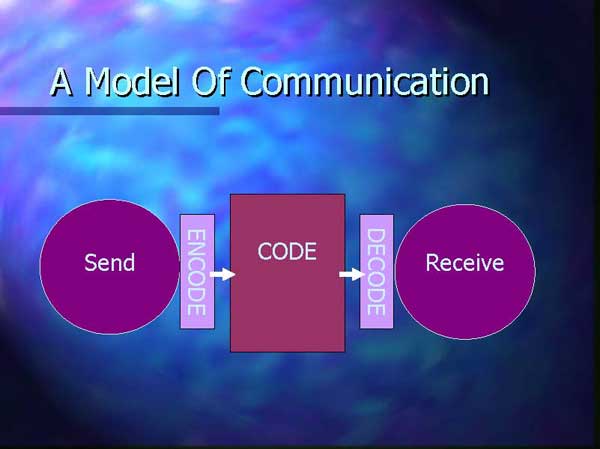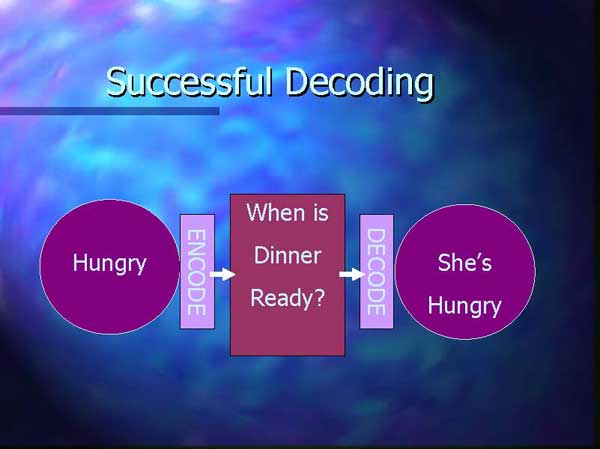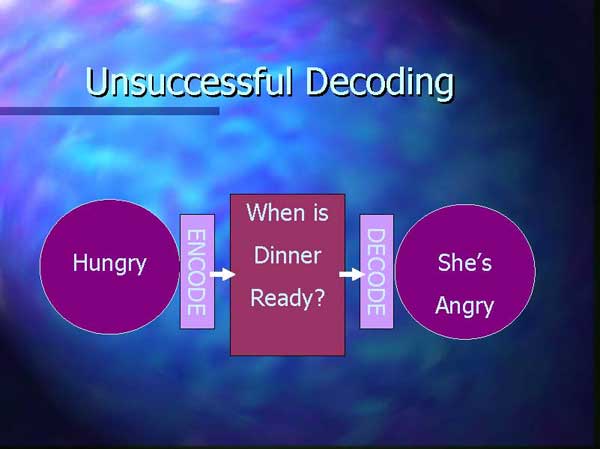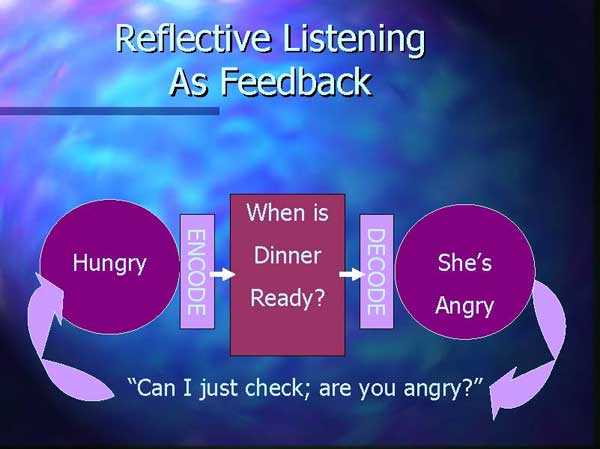WordPress database error: [Table 'adding_b51201.wp_SBConfiguration' doesn't exist]select * from wp_SBConfiguration where id='1'
Welcome to Module 4.2 Return to Dashboard
[audio:http://www.transformingcommunication.com/wp-content/uploads/2010/11/4_Track_324.mp3|titles=Module4.2.mp3]Transforming Communication Module 4.2
When you use reflective listening, you enable the other person to solve their own problem. If I hadn’t ask you to only use reflective listening, what would you have been tempted to do when your friend said that first statement? You probably would have ask why. And you probably would have been tempted to give advice when you found out about the speech in front of the class. Right?
And the saddest thing about that “diagnose and prescribe” style of helping is that it might have worked. Your friend might have stopped complaining and tried to take your advice…. And you would never have heard about their other feelings of self doubt, and they would never have worked through the issue with Robert; so in future other similar situations would probably have occurred.
If you gave your friend advice, they might have ended the conversation feeling really good about you and your ability to solve problems. Actually they still did. But more important; the way you did it this time, they ended up feeling really good about themselves and their ability to solve problems. The sense of it being safe to explore, which you gave them, enabled them to discover the real issues, that they hadn’t even been fully conscious of before.
You gave them a sense of being understood, of empathy. That sense of acceptance and understanding (or empathy, to use a word which means to feel with someone) is uncommon in life. Empathic, reflective listening is like a precious jewel. In a society full of loneliness, anxiety, and frustrations, it is rare indeed that you find someone who really wants to listen, someone who trusts that you can find solutions which will work for you. This skill is too important to leave it only to the counsellors and other professionals.
It is worthwhile for you to practice these reflective listening skills. Be careful, however, not to repeat, in a parrot-like fashion, what the other person has said. What you are interested in is the basic meaning of what has been said. State what the other person has said in your own words. To make your reflection sound less formal, start with the word “And…”; avoiding the words “So…” and “So you feel…” also often helps to make your reflecting listening less stereotypical and formal.
The following diagram was developed by Claude Shannon and Warren Weaver (1949 “The Mathematical Theory of Communication”) to explain how communication occurs:

When one person sends a message to another, as this diagram shows, the person sending the message (represented as the circle on the left) has to ‘encode’ their thoughts and feelings. They have to find some words or actions that will be a code for their meaning. The person receiving the message (in the circle on the right) can’t read their mind; they have to ‘decode’ the words or actions to understand what was meant. In the following example, a person who feels hungry asks the person cooking, “When is dinner?’ The words are their code. The receiver has to decode this to understand what was meant.

But what if the receiver decodes wrongly? Perhaps this receiver can remember another time when someone asked ‘When is dinner’ and that person was angry about dinner being late. The receiver might well now decode this message as meaning that the sender is angry. After all, ‘When is dinner’ is not a very clear code for this message, ‘Im hungry’.

A smart receiver could also check that they got the right message, by using reflective listening. This will help the sender know whether they’ve been understood. The sender’s next coded message will then be a clearer code (eg. ‘No, I’m just hungry, and that sure smells good!’). Reflective listening encourages clearer messages. When the sender of the message hears your restatement, it helps them to clarify what they meant. So reflective listening promotes change in the way the speaker thinks about their situation. Notice that even if the reflective listening is not “correct” (the person isn’t really angry) it still works!

In reflecting, you aim to reflect the basic meaning that the person tried to communicate. This basic meaning includes the information, or ‘content’ (about the timing of dinner in this case) and the feeling states the person is experiencing (hunger or anger, for example). The feeling state is often more important than the content. It would seem unusual in the example to reply to “When is dinner?” with a simple “6.35pm” and ignore the possibility of a feeling state. When the person hasn’t named the feeling states themselves, the listener needs to ask themselves ‘In this situation, how would I be feeling?’, and ‘From this person’s body language, what do they seem to be feeling?’ Being in a similar body position to the speaker can help you identify feelings. When you reflect feeling states, you are often less certain of having understood then when you reflect information.
Sometimes it helps to explain this in the way you reply, for example, It almost sounds like you felt…’, “You feel… is that it?’, From the way you say that, I get the impression you feel…’. Having reflected the meaning as you’ve understood it, your next step needs to be listening for confirmation. If your reflection was accurate, the person will usually nod, say ‘yes’, or continue talking almost unaware of your presence. If your reflection sounds different to what they meant, they may frown, shake their head, or attempt to re-explain. Either way, your reflection has worked!
In order to get unconsciously skilled at the process of reflective listening, you will want to practice it repeatedly. Would that be useful?
Here is an exercise you can do with two other friends. One person will be the Speaker, another one the Listener, and the third one the Observer. (If you have only one other person to practice with, the exercise can be done with 2 people too). Here’s what you will be doing:
The Speaker
You will talk about an issue that genuinely concerns you. This may be a problem you have, a decision you are exploring, a relationship you would like to think more about, a long term personal change issue you would like to think about, an improvement you would like to make in you life etc. The issue should be:
– Real
– Okay to talk about
– Important enough to talk aboutWhen you talk, pause after each couple of sentences and give the listener a chance to reflect: remember, they are learning. If you take up the full six minutes talking, they won’t have a chance to practise their skill. As you listen to their reflection, think about whether it sounds as if they have understood, and check what else comes into your mind to continue talking about.
The Listener
You will listen and use reflective responses. When you are listening, check first of all that you are in an attending/rapport building posture – ask the person who will be speaking what feels right for them. Remember, you dont have to ‘solve’ the concern the person raises. Your job is simply to understand. Use only reflective listening, so you get the chance to really learn this new skill.
The Observer
You will keep time, and observe the listener. At the end of the six minutes, the observer will encourage the speaker and listener to say how they found it went. The observer can then tell the listener what they seemed to do well. If you are the observer, remember that it helps the listener to hear specifically what was said or done that was useful. It also helps them to know if they lost track of what they were doing or used any of the roadblocks (denial, judgements, solution sending, or interrogating).
Swap roles and repeat the exercise twice more, so each person has a practice. You can then discuss what you’ve learned that will be useful for you.
Please note that some people will have had negative past experiences with a person using reflective listening in a rather inept and technical way with them. They will say that the method irritates them. One choice is to respond by saying “And it’s because it sounds like a contrived technique rather than a genuine attempt to understand you?” and when they say more about that add another reflection. In this case you model reflecting using a less stereotyped format (which is what has annoyed them in the past). As mentioned above, starting with the word “And…” is particularly useful in making your reflection sound less formal. Avoiding the words “So…” and “you feel…” also helps.
Until the next module, use the reflective listening process repeatedly. If it’s possible for you, arrange with someone to spend a short session of reflective listening. It will be fun, and both of you will practice this important skill.
Milton Erickson’s first comment to 3 year old Robert was “That hurts awful, Robert! That hurts terrible.” Robert nodded. “And it will keep right on hurting. And you really wish it would stop hurting.” Robert nodded. “And we don’t know if it will stop in one minute, or in two minutes.” Robert agreed. This also was very true. Erickson continued, pointing to the blood which had so terrified Robert. “That’s an awful lot of blood on the pavement.” So far, all Erickson had done was reflective listening, speaking Robert’s deepest fears and thoughts. He had Robert’s full attention. Milton continued “Is it good strong red blood?” A harmless enough question. Robert wasn’t sure. Milton explained that if it was good strong red blood, it would turn the water pink. They went into the bathroom, and washed up Robert’s face. Sure enough, the water turned pink. Robert was very impressed. Milton began to carry on talking about the stitches Robert would get, just as his older brother Allan and older sister Betty Alice had had. Milton speculated as to whether Robert would be able to get as many stitches as they had had. Robert was very curious about it. There is a certain art to what Milton is doing here. But notice how simply it begins. His first several statements, until Robert’s feelings are fully acknowledged, were simple reflective listening. They don’t require great skill. But they do make an extraordinary difference.